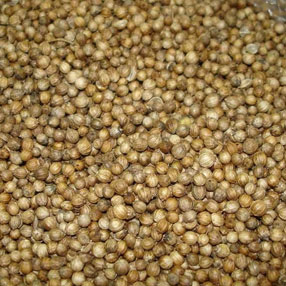

Coriander Seeds

We are dealing with
Bold – eagle, scooter, parrot
Small – eagle, scooter, parrot, double parrot
Split – eagle, scooter
Also known as dhania seeds, akha dhania.
Coriander is one of the oldest herbs and spices on record. Coriander seeds are tan-colored, ribbed, lightweight fruits with subtle flavor that is warm and spicy with a slight hint of citrus flavor. Coriander spice has an aromatic sent which is soothingly warm, nutty, slightly fruity, and complex. Like other spices coriander is available throughout the year providing a fragrant flavor that is reminiscent of both citrus peel and sage. The fruit of the coriander plant contains two seeds which, when dried, are the portions used as the dried spice. When ripe, the seeds are yellowish-brown in color with longitudinal ridges. Coriander seeds are available whole or in ground powder form.
History
First attested in English late 14th century, the word coriander derives from the Old French coriandre, which comes from Latin coriandrum, in turn from Greek κορίαννον (koriannon). The earliest attested form of the word is the Mycenaean Greek ko-ri-ja-da-na (written in Linear B syllabic script, reconstructed as koriadnon), similar to the name of Minos’ daughter Ariadne, and it is plain how this might later evolve to koriannon or koriandron.
Cilantro is the Spanish word for coriander, also deriving from coriandrum. It is the common term in North America, due to its extensive use in Mexican cuisine.
Coriander grows wild over a wide area of the Near East and southern Europe, prompting the comment, “It is hard to define exactly where this plant is wild and where it only recently established itself.” Fifteen desiccated mericarps were found in the Pre-Pottery Neolithic B level of the Nahal Hemel Cave in Israel, which may be the oldest archaeological find of coriander. About half a litre of coriander mericarps were recovered from the tomb of Tutankhamen, and because this plant does not grow wild in Egypt, Zohary and Hopf interpret this find as proof that coriander was cultivated by the ancient Egyptians. The Bible mentions coriander in Exodus 16:31: “And the house of Israel began to call its name manna: and it was round like coriander seed, and its taste was like that of flat cakes made with honey.”
Coriander seems to have been cultivated in Greece since at least the second millennium BC. One of the Linear B tablets recovered from Pylos refers to the species as being cultivated for the manufacture of perfumes, and it appears that it was used in two forms: as a spice for its seeds and as a herb for the flavor of its leaves. This appears to be confirmed by archaeological evidence from the same period: the large quantities of the species retrieved from an Early Bronze Age layer at Sitagroi in Macedonia could point to cultivation of the species at that time.
Coriander was brought to the British colonies in North America in 1670, and was one of the first spices cultivated by early settlers.
